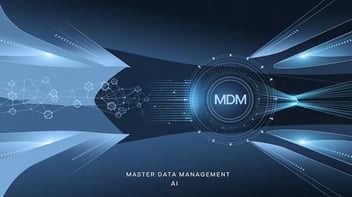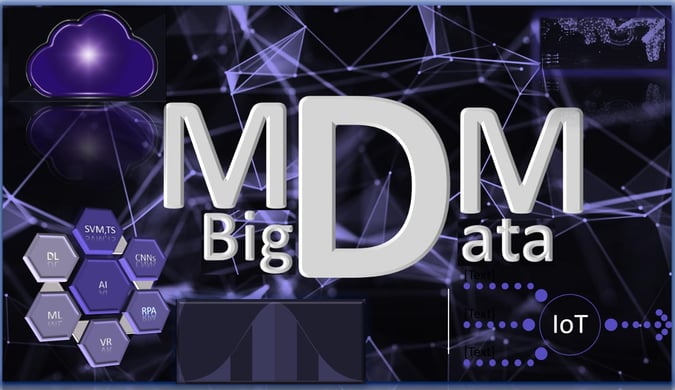
Today’s world is all about choices and options, the data world isn’t an exception for this. An enterprise generally ends up using umpteen number of technology stacks and tools in their digital transformation and data governance journey. The biggest challenge the most organizations that implement an MDM solution face is how to make MDM fit their existing IT ecosystem without disturbing the balance. More specifically, how to integrate MDM with existing data programs and technologies of tomorrow to harness desired output from each of these units. Good thing is MDM can work in tandem with most of the latest technology trends such as Big Data, AI, ML, IoT, Cloud etc. as well as the legacy ones.

In fact, some of the MDM solutions have started using AI and ML within their product functionalities to enhance product and user experience. Let’s see how MDM can work in close association with other technology stacks and yield better results for the data programs.
MDM & Big Data:
Until few years ago, what MDM and Big Data did were thought to be diametrical and rightly so. MDM’s primary engagement is to create a well-structured, trusted data source for business-critical data attributes, whereas Big Data deals with storage, access and handling of data of mammoth volumes with high velocity, variety and veracity, which is often unstructured or semi-structured at best. This special ability of Big Data to deal with this kind of chaotic data is the very factor that makes it suffer in some but vital data aspects namely accuracy, identity, data quality, relatability and (additional) privacy. MDM can bail out Big Data on these fronts as dealing with these aspects is MDM’s wheelhouse.
MDM can enable Big Data with:
- Accuracy through its trusted, consolidated golden record information and 360-degree view.
- Identity by giving that data a proper context through its cross-reference lineage and history.
- Data Quality through its data cleansing, standardizing and enriching abilities.
- Relatability through its Hierarchy Management by linking entities between the domains across the enterprise.
- (Additional) Privacy through its Security Manager while exposing and publishing the data.
To paraphrase technically, MDM can provide Dimensions for analyzing Big Data Facts.
On the other hand, Big Data can lend some of its core strengths to make MDM powerful too. Big Data can provide additional insights and information to MDM about customers and products from web & social media feeds, transactional systems and machinery equipment. These helps augment MDM’s golden record information with vital real-time facts. Also, MDM can find avenues to improve data access during matching and consolidation processes through Big Data’s columnar storage, key-value storage (NoSQL database) and In-memory database.
Enterprises are starting to see the benefits MDM and Big Data could bring together. According to a survey result by The Information Difference Ltd., an MDM Research firm, “67% of survey respondents saw MDM driving Big Data, rather than the other way around, with just 17% seeing Big Data producing new master data”. The most popular choice was for existing MDM data to help drive Big Data initiatives.
Bottom-line is that MDM and Big Data are more of companions than the disparate entities they have thought to be and they can make each other better together.
MDM & Cloud:
Off late, Cloud Computing is casting its shadow on the entire technology world, MDM is no exception. Like they say, everything is better with cloud, so is MDM. The Cloud MDM has become such a hit these days that most of the MDM providers such as Informatica, IBM, Reltio, Talend, Tibco, Profisee are providing MDM solutions on cloud. Below are some of the selling points of Cloud MDM.
- Swift Deliveries & Improved Time to Value: Most Cloud MDMs come as a SaaS package with pre-configured data models. This helps organizations to implement their MDM solutions swiftly and see tangible impact on their business in a short time.
- Cost Efficient: Cloud MDMs offer a cost-effective way of implementing MDM initiatives since the entire infrastructure is maintained by the provider and needs less resources to customize the solution owing to its pre-configured data model and ease of usage.
- Hybrid Deployments: Cloud MDMs offer hybrid mode of deployments to allow organizations to reap benefits of the cost effectiveness of a public cloud infrastructure (choose when computing resources is the primary need) and the iron-clad security and privacy of a private cloud (choose when security is of paramount importance) as per their needs.
Cloud MDMs inherit the following features from Cloud itself that add a lot of value to enterprises.
- High availability: Cloud MDMs promise almost zero down time, can provide uninterrupted access to master data
- Agile and Scalability: Cloud MDMs can easily adapt to changing data sources without any tedious customizations and be easily scaled to support real-time operations.
- Robust Backup: Cloud MDMs manages a full back-up of the implementation, so the organizations never have to worry about disaster recovery or contingency.
AI and ML are dipping their toes practically in all domains and technology stacks these days. Seems like AI, ML are the way of the future and MDM has already joined the pack. Some MDM providers have already started inculcating the AI & ML training algorithms to produce and better the master data.
Within MDM, AI & ML models can train on data patterns, data regularities and irregularities over a period of time, then be able to spot new data patterns, let the data stewards know of the data changes in source systems and even suggest changes to data cleansing rules to developers. The training can be extended to match patterns as well to equip the MDM match engine to either recommend the tunings to be done to match rules for better match quality.
AI Chatbots with speech-to-text and Natural Language Processing abilities would be really a cool feature in E360/P360/S360 user pages. These dandy features can help data stewards make the searches efficiently and get the master data information they want more quickly when there are hundreds of master data attributes. Also, AI models can learn the stewardship behavior over time and make intelligent suggestions to data stewards. It wouldn’t be an exaggeration if one were to say Automated Data Stewardship isn’t a distant dream in MDM.
Conclusion:
MDM can easily co-exist peacefully with other technology stacks. MDM can not only benefit itself from these technological advancements but also can drive the initiatives in these tech stacks. Besides, MDM has no other choice but to adapt to this brave new technology world to be pertinent to the future.

Posted by PDI Marketing Team
Pacific Data Integrators Offers Unique Data Solutions Leveraging AI/ML, Large Language Models (Open AI: GPT-4, Meta: Llama2, Databricks: Dolly), Cloud, Data Management and Analytics Technologies, Helping Leading Organizations Solve Their Critical Business Challenges, Drive Data Driven Insights, Improve Decision-Making, and Achieve Business Objectives.




